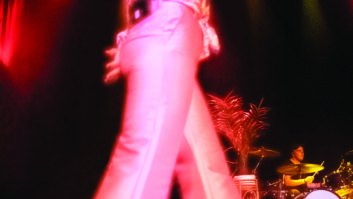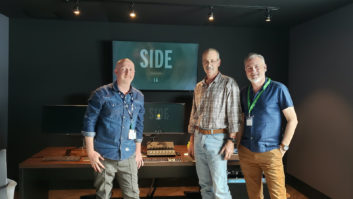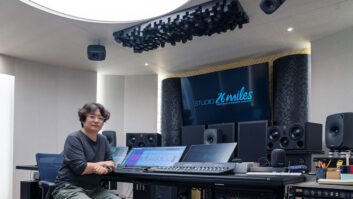Oberlin, OH (July 11, 2011)–The Oberlin Conservatory of Music has introduced its new recording facility, the Joseph R. Clonick Studio, which also serves as a performance venue.
 The Clonick Studio utilizes products from BAE; Ed Meitner of EMM Labs; Gotham; Grace Design; iZ Technology Radar; JL Audio; Mogami; Richard Schram and Parasound; Maurice Patist and PMC; Rupert Neve Designs; Gus Skinas and DSD; and Sterling Modular Systems.
The Clonick Studio utilizes products from BAE; Ed Meitner of EMM Labs; Gotham; Grace Design; iZ Technology Radar; JL Audio; Mogami; Richard Schram and Parasound; Maurice Patist and PMC; Rupert Neve Designs; Gus Skinas and DSD; and Sterling Modular Systems.
“The room was designed for surround sound—an immersive musical experience in which the music is captured with more depth,” says Michael Lynn, associate dean of the Conservatory, who served as project liaison. “Oberlin wanted to offer students the experience of working within a real recording studio, to give them a shot at making a spectacular recording. The studio will afford our students free and direct access to high-level excellence in recording new music, old music and everything in between.”
The centerpiece of the control room is the Rupert Neve Designs (RND) 5088 console, a 24-track, discrete analog mixer outfitted with Tonelux Shadowmix fader automation. “The RND 5088 is distinguished by its neutrality and high headroom, both of which are critical in our jazz and classical applications,” says acoustic consultant Dana Kirkegaard, of Kirkegaard Acoustic Design, LLC, of Downers Grove, IL. “We selected the RND after carefully auditioning desks in Los Angeles; the great sound and solid feel of the console was critical in our decision.”
Sterling Modular Systems Inc., a Pennsylvania-based company that designs and produces furniture for the audio recording and broadcast industries, built the custom console that houses the RND 5088. “The selection of Sterling to build the custom console was based upon our desire for an array of analog outboard equipment within easy reach,” says Kirkegaard. “Sterling offers a standard console for the RND 5088 and matching patchbays that are quite handsome and well built, and with excellent acoustic properties. We started with that design and modified the patchbays to serve as side racks; we then wrapped the console around the operator to facilitate access to the equipment. One of the features that puts the console design over the top is an automated monitor stand that raises and lowers a pair of Apple cinema displays at the touch of a button.”
The construction of the Clonick Studio is an especially noteworthy achievement in a time when recording studios are declaring bankruptcy due to a rise in more economical, often lesser-quality digital recording formats. “I think that what Oberlin is doing to support the arts is really extraordinary,” comments Kirkegaard. “Studios have been closing all over the place for 5 to 10 years, and here we are building a studio. That’s a huge credit to the conservatory and their leadership. A place like Oberlin is in a unique position to build a studio at the highest level and support these artists.”
Pianist and composer Hiromi Uehara recently mixed her newest CD with Cleveland-based producer Michael Bishop in the studio’s control room. Bishop is one of the studio’s first end-users; his Five Four Productions, an audio team formerly associated with Telarc Records consisting of Bishop, Robert Friedrich, and Thomas Moore, has 15 technical Grammy Awards to its credit. Bishop says that he and his colleagues typically travel to recording studios in Los Angeles and New York City in order to meet their clients’ needs. With the arrival of the Clonick Recording Studio, he is now able to supplement his technical requirements closer to home.
Spearheaded by Kirkegaard and Lynn, plans for the recording studio began in 1999. A desire to rehearse Oberlin’s large jazz ensemble inspired the size of the room. Once the dimensions of the space had been determined, acoustic consultants were able to turn the space into a recording facility for all kinds of music, taking sound isolation and acoustic treatments into careful consideration. According to director of Audio Services, Paul Eachus, Oberlin’s chief recording engineer, the Clonick Studio “is unique to this region; there just isn’t anything like it being built right now.”
The facility has also attracted the attention of other luminary musicians. Cellist Zuill Bailey, pianist Orli Shaham, Richard King, principal hornist of the Cleveland Orchestra, and Tod Bowermaster, third hornist of the St. Louis Symphony, are among the classical musicians that have come to Oberlin to record. Amidst dedication events for the Kohl Building, which houses the Clonick Studio, music legend Stevie Wonder spent 40 minutes playing the new Hamburg Steinway. During a concert appearance in Oberlin in March 2011, Esperanza Spalding, the acclaimed jazz double bassist and vocalist and winner of the 2011 Grammy Award for Best New Artist (the first jazz musician to ever win the award), visited the studio and expressed a desire to record there as well.
The Oberlin Conservatory of Music: new.oberlin.edu/conservatory
The Bertram and Judith Kohl Building: www.oberlin.edu/kohl
Rupert Neve Designs: www.rupertneve.com
Sterling Modular Systems Inc.: www.sterlingmodular.com
BAE: www.baeaudio.com
Ed Meitner, EMM Labs: www.emmlabs.com
Gotham: www.gothamaudiousa.com
Grace Design: www.gracedesign.com
iZ Technology: www.izcorp.com
JL Audio: home.jlaudio.com
Mogami: www.mogamicable.com
Parasound: www.parasound.com
PMC: www.pmc-monitors.com
Gus Skinas and DSD: www.superaudiocenter.com







